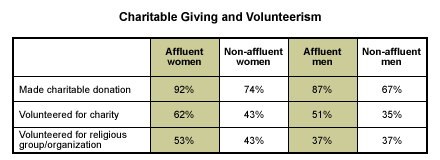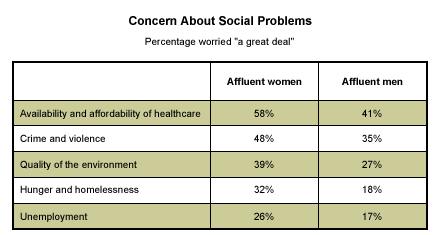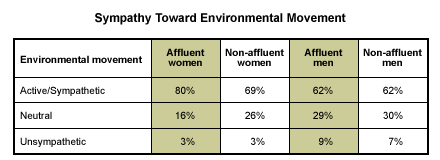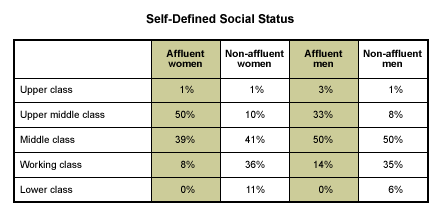Over the last few decades, there has been a rapid rise of affluence in America. According to 2003 Census figures, one in every four households in the country is now "mass affluent," -- defined as people living in households with annual incomes of $75,000 and higher -- compared with only about one in seven in 1980. This article is the fourth in a series examining this demographic segment and focuses on mass affluent women.
While affluent women are an attractive and influential segment to marketers, ║┌┴¤═° surveys reveal there is much more to these women than their supposed spa habits or fondness for luxury goods*. Affluent women outshine affluent men and non-affluent women in social activism, generosity with charitable causes, and environmental consciousness.
Affluent Women Give Time and Money
Affluent women are no more likely than affluent men to make financial charitable contributions, but they are somewhat more likely to give of themselves. About 9 in 10 affluent women and affluent men say they have made charitable contributions in the past year -- not surprising given they have the financial means to write a check with relative ease.
But when asked about their activities in the previous 12 months, 6 in 10 affluent women (62%) say they have volunteered their time on behalf of a charity, compared with 51% of affluent men. Roughly half (53%) of affluent women have volunteered time to a religious group or organization, compared with 37% of affluent men. These rates of financial giving and charity also sharply differentiate affluent women from non-affluent women.

Affluent women's sense of civic responsibility also manifests itself in their concerns about a variety of social problems. In a poll measuring public concern about 11 separate issues, affluent women show higher concern than affluent men do on 5 issues (higher social concern is typical of women, compared with men more generally). A significantly higher proportion of affluent women, as compared with affluent men, say they worry "a great deal" about healthcare, crime, the environment, hunger and homelessness, and unemployment.

Environmental Concern
║┌┴¤═°'s extensive polling on environmental matters finds affluent women consistently more concerned than affluent men about these issues. Four in five affluent women (80%) consider themselves active in, or sympathetic to, the environmental movement, compared with 62% of affluent men and 69% of non-affluent women.

Similarly, 58% of affluent women favor making environmental protection the priority when environmental and economic interests conflict; only 45% of affluent men share this opinion. Affluent women are also markedly more pessimistic than affluent men about the outlook for environmental quality in the United States, and they are more likely than all others to say global warming is an immediate problem. Close to three-quarters of affluent women believe the effects of global warming are already manifest, compared with only half of affluent men and all non-affluent men and women.
Class Distinction
Finally, whatever picture of affluent women this collection of data may paint, it is worth noting that the social consciousness evident among affluent women is paired with a relatively high regard for their own social status.
Affluent women are much more likely than affluent men to consider themselves "upper-middle class," as distinct from being "middle class." About half (51%) of affluent women identify themselves as upper middle class or upper class, compared with just 36% of affluent men. (Only about 10% of non-affluents see themselves in these terms.)

Such self-perceptions suggest that rather than identifying with those who are the recipients of their altruism, affluent women tend to remain acutely conscious of the differences between them.
*Results are based on telephone interviews with 3,029 national adults, aged 18 and older, conducted May 2001, May 2002, and May 2003. For results based on the total sample of national adults, one can say with 95% confidence that the margin of sampling error is ±2 percentage points.
